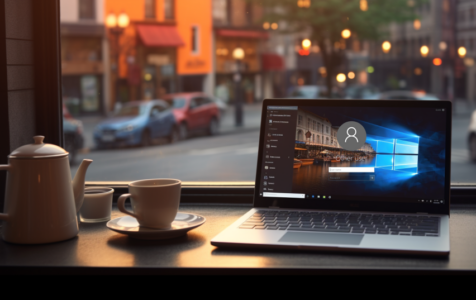Auto-login lets you skip the Windows 10 password screen, taking you directly to your desktop when you start your computer. This article details three methods for enabling this feature: Standard Method, Registry Method, and Autologon App Method. We’ll also show you how to turn off the requirement to enter a password when your computer wakes up from “sleep” mode. Additionally, we talk about the Dynamic Lock feature, which locks your computer when you move away from it. For those who run into difficulties, the Troubleshooting and Recovery section pinpoints common challenges based on real user experiences, providing potential solutions.
Security Notice: Disabling your login password decreases the security of your computer. This should only be done on personal computers that are not shared and are maintained in a secure environment.
Standard Method
Steps:
- Press the two keys
Windows Key + Rtogether on your keyboard. This will open a small box on your screen where you can run commands. - Type
netplwizinto that box and press the “Enter” key. This will open up a window that lists all the user accounts on your computer. - Locate “Users for this computer,” and choose your username.
- Uncheck the option that says, “Users must enter a username and password to use this computer,” then click Apply.
- A new window will prompt you for your password. Enter it twice and click OK.
Note: This only bypasses the login during startup, not when unlocking your PC from sleep.
Expert Tip: For smoother PC performance, consider using a PC optimization tool. It handles junk files, incorrect settings, and harmful apps. Make sure it's right for your system, and always check the EULA and Privacy Policy.
Special offer. About Outbyte, uninstall instructions, EULA, Privacy Policy.
Turn Off Password Requirement After Sleep Mode
If you wish to remove the password after sleep, go to Settings > Accounts > Sign-in options and modify the settings as needed.
Registry Method (Advanced Users)
Risk Warning: Modifying the Windows Registry carries risks and can cause irreversible damage to your operating system if done incorrectly. Always make sure to back up your system before making such changes.
This method is for more advanced users and can be risky. If done incorrectly, it might cause problems with your computer. So, it’s a good idea to create a “restore point” first, which is like a backup for your settings.
Steps:
- Press
Windows Key + Rand typeregedit. - Navigate to
HKEY_LOCAL_MACHINE\SOFTWARE\Microsoft\Windows NT\CurrentVersion\Winlogon. - Modify
DefaultUserNameto your username. - Create a new string value
DefaultPasswordif it doesn’t exist. - Double-click
DefaultPasswordand input your password.
Autologon App Method
Use Microsoft’s Autologon app for a simpler way to turn auto-login on or off. Just download the app and follow the on-screen instructions.
Steps:
- Download the Autologon app from Microsoft’s official website.
- Follow the on-screen instructions.
Note: A portable version is available for download.
2. Additional Features and Tools
Dynamic Lock
To use the Dynamic Lock feature, you’ll need to connect a Bluetooth device (like your phone) to your computer. When you move away from your computer with your Bluetooth device, your computer will automatically lock itself for security.
Steps:
- Pair a Bluetooth device with your computer.
- Go to Settings and enable Dynamic Lock.
3. Troubleshooting and Recovery
Setting up auto sign-in on Windows 10 promises convenience, but the reality can be anything but straightforward. Users often find themselves wrestling with unexpected challenges, which makes one question the usability of this feature. For instance, a discussion on the Microsoft community forum reveals that users face issues such as:
- The system repeatedly failing to recognize passwords, making a supposedly simple process complicated.
- Ambiguity between Microsoft Account and Local Account login credentials, requiring users to tinker with various settings.
- Mysterious error prompts that seem to suggest the user account is “invisible,” adding another layer of confusion to the sign-in process.
Various solutions are often suggested, ranging from converting your Microsoft Account to a Local Account, modifying sign-in settings, to even more technical steps like adjusting the Windows Registry. Yet, users have reported mixed success with these methods.
This user feedback suggests that there’s room for improvement in how Windows 10 handles auto sign-in, pointing to the need for a more user-friendly interface and better functionality from Microsoft.
Missing Checkbox
If the checkbox in the Standard Method is missing, additional steps may be required to restore it. These could include running specific commands as an admin.
Registry Errors
Should you encounter any issues with the Registry Method, revert to your restore point or consult technical forums or guides for a solution.
4. Safety Precautions
- Use auto login only on personal, secure computers to avoid compromising data.
- Erroneous edits in the Windows Registry can cause issues, so proceed cautiously.
Conclusion
This guide offers multiple methods for enabling auto login on your Windows 10 machine. Choose the one that aligns with your level of comfort and expertise, but remember that each method comes with its own set of safety considerations.
